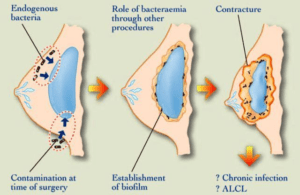Many undergo implant removal surgery for several reasons—a change in lifestyle or complication from the original breast augmentation, causing the need for reconstruction or removal. Usually, the capsule surrounding the breast implant is soft and does not cause discomfort. Unfortunately, for some patients, the implant hardens and produces chronic pain. It means the complication capsular contracture is present and will require a capsulectomy surgery.
According to the International Journal of Surgery Open, capsular formation is common. It accounts for 8-15% of women who undergo breast augmentation or breast reconstruction procedures. A primary reason is to have scar tissue, leaked silicone substance, and breast implants removed.
Our body’s natural healing process is to protect itself. It automatically goes into fight mode. Are you experiencing thickening or hardening of the regions around your breast, along with pain and irritation? Your body is telling you something is wrong. It is time to call our office and schedule a consultation with Dr. Barrett, a leading Beverly Hills board-certified plastic surgeon. Our caring team is ready to listen to your concerns and answer any questions to keep you at ease during the process.
Unfortunately, breast implants have a shelf life and will need to either be replaced after so many years, removed due to failure, or health risk.
Our patients’ health and safety are most important at Barrett Plastic Surgery. Rosalyn, our patient coordinator, oversees patient care at every level and is ready to answer all procedural and surgery-related questions. She understands the impact of a life-changing procedure.
To help you better understand the condition, below is a list of the most frequent questions regarding Capsular Contracture, which has distinct levels and is measured on a four-grade scale known as the Baker’s Classification.
BAKER GRADE I: the breast is naturally soft and appears consistent in size and shape
BAKER GRADE II: the breast is slightly stiff yet looks healthy
BAKER GRADE III: the breast is hard and looks unnatural
BAKER GRADE IV: the breast is dense, has severe pain with touch, and appears irregular
Grade I and Grade II capsular contracture generally do not require surgery. Patients who experience Grade III and Grade IV capsular contracture most likely will undergo surgery or a minimally invasive procedure to achieve natural-looking breasts. These patients are encouraged to quit smoking. It will aid with blood flow and help the body in the healing process significantly. Additionally, discontinuing certain medications is necessary.
What Causes Capsular Contracture?
The formation of a capsule following a breast implant procedure is normal because it keeps the implant in place and protects it, which is the body’s natural response to defend itself. Some patients develop complications such as capsular contracture after augmentation when the body produces collagen fibers in excess, hardening the capsule.
If you currently have or are experiencing the following conditions, you are at an increased risk for capsular contracture:
 • You have undergone radiation therapy
• You have undergone radiation therapy
• Biofilm formed by contamination of the shell of the implant
• Hematoma (the buildup of blood during surgery)
• Seroma (the buildup of water) underneath the skin
• Rupturing of the implant
• Genetic predisposition
The consensus by accredited surgeons is the type of breast implant affects capsular contracture formation. There is a higher risk of scar tissue development with silicone gel implants because silicone has a higher tendency to form thicker scar tissue while textured breast implants reduce the risk of developing capsular contracture compared to smooth.
What Are the Steps in Capsular Contracture Surgery?
Once sedated, Dr. Barrett will make an incision along the initial scar from your augmentation, removing the envelope surrounding the implant where the implant is removed or reinserted. Once the incision is closed, the breasts are wrapped with gauze; patients are moved to recovery for monitoring before being cleared to go home. Most can leave within 24 hours after the procedure.
What does a Capsulectomy Entail?
There are three types of capsulectomy surgery: Total, En bloc, and Subtotal. The total capsulectomy procedure involves the removal of the breast implant, along with the entire capsule of scar tissue. A small scar may result. The En bloc capsulectomy is the total capsulectomy. Removal of the breast implant and capsule is simultaneous. This option is more beneficial when you have a ruptured breast implant. The subtotal capsulectomy is a partial removal of the capsule with a smaller incision.
What Are the Differences Between a Capsulectomy and Capsulotomy?
Though both terms sound similar, there is a difference among their suffices, “ectomy” is when removing something occurs, and “tomy” is to make an  incision in the tissue.
incision in the tissue.
A capsulectomy is the more invasive procedure as part of your breasts’ capsule is removed and the implant replaced. During a capsulotomy, the opening of the capsule allows the implants more space. A capsulotomy can be open with the breast’s incision to access the capsule or closed where manual compression is applied on the breast’s surface to break apart the scar tissue. Dr. Barrett will determine which is right for you.
Recovering After Capsular Contracture Surgery?
The time it takes to recover varies by patient and depends on the procedure completed and the patient’s ability to heal. You may or may not feel breast soreness following the surgery. Dr. Barrett Plastic Surgery strongly recommends wearing the compression bra for a few days or weeks to give your breasts extra support. The general healing period is roughly two weeks. You must avoid strenuous activity and smoking during this time to allow the body to heal from the stitches properly.
If you are a person enduring any capsular contracture symptoms, we hope we have eased your mind and helped answer some of your questions. If you like this article, please share it with your friends and family. Do you want to learn more about Barrett Plastic Surgery? Subscribe to our blog, and follow us on social media at Twitter, TikTok, Instagram, Realself, YouTube, Snapchat, Yelp, and Facebook for updates.
Thank you for visiting!

